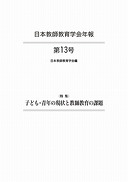Volume 13
Displaying 1-26 of 26 articles from this issue
- |<
- <
- 1
- >
- >|
-
2004 Volume 13 Pages 3-5
Published: September 15, 2004
Released on J-STAGE: October 02, 2020
Download PDF (638K)
-
2004 Volume 13 Pages 8-14
Published: September 15, 2004
Released on J-STAGE: October 02, 2020
Download PDF (1353K) -
2004 Volume 13 Pages 15-20
Published: September 15, 2004
Released on J-STAGE: October 02, 2020
Download PDF (1156K) -
2004 Volume 13 Pages 21-26
Published: September 15, 2004
Released on J-STAGE: October 02, 2020
Download PDF (1193K) -
2004 Volume 13 Pages 27-31
Published: September 15, 2004
Released on J-STAGE: October 02, 2020
Download PDF (1122K) -
2004 Volume 13 Pages 32-37
Published: September 15, 2004
Released on J-STAGE: October 02, 2020
Download PDF (1056K) -
2004 Volume 13 Pages 38-44
Published: September 15, 2004
Released on J-STAGE: October 02, 2020
Download PDF (1224K) -
2004 Volume 13 Pages 45-51
Published: September 15, 2004
Released on J-STAGE: October 02, 2020
Download PDF (1294K) -
2004 Volume 13 Pages 52-57
Published: September 15, 2004
Released on J-STAGE: October 02, 2020
Download PDF (1134K) -
2004 Volume 13 Pages 58-63
Published: September 15, 2004
Released on J-STAGE: October 02, 2020
Download PDF (1317K) -
2004 Volume 13 Pages 64-71
Published: September 15, 2004
Released on J-STAGE: October 02, 2020
Download PDF (1360K)
-
2004 Volume 13 Pages 74-83
Published: September 15, 2004
Released on J-STAGE: October 02, 2020
Download PDF (1647K) -
2004 Volume 13 Pages 84-93
Published: September 15, 2004
Released on J-STAGE: October 02, 2020
Download PDF (1481K) -
2004 Volume 13 Pages 94-104
Published: September 15, 2004
Released on J-STAGE: October 02, 2020
Download PDF (1460K) -
2004 Volume 13 Pages 105-119
Published: September 15, 2004
Released on J-STAGE: October 02, 2020
Download PDF (2013K)
-
2004 Volume 13 Pages 122-132
Published: September 15, 2004
Released on J-STAGE: October 02, 2020
Download PDF (1554K)
-
2004 Volume 13 Pages 134-136
Published: September 15, 2004
Released on J-STAGE: October 02, 2020
Download PDF (788K) -
2004 Volume 13 Pages 137-139
Published: September 15, 2004
Released on J-STAGE: October 02, 2020
Download PDF (785K) -
2004 Volume 13 Pages 140-143
Published: September 15, 2004
Released on J-STAGE: October 02, 2020
Download PDF (891K) -
2004 Volume 13 Pages 144-145
Published: September 15, 2004
Released on J-STAGE: October 02, 2020
Download PDF (637K)
-
2004 Volume 13 Pages 148-162
Published: September 15, 2004
Released on J-STAGE: October 02, 2020
Download PDF (2506K)
-
2004 Volume 13 Pages 162-173
Published: September 15, 2004
Released on J-STAGE: October 02, 2020
Download PDF (2068K)
-
2004 Volume 13 Pages 174-181
Published: September 15, 2004
Released on J-STAGE: October 02, 2020
Download PDF (1397K)
-
2004 Volume 13 Pages 181-190
Published: September 15, 2004
Released on J-STAGE: October 02, 2020
Download PDF (1635K)
-
2004 Volume 13 Pages 194-195
Published: September 15, 2004
Released on J-STAGE: October 02, 2020
Download PDF (631K)
-
2004 Volume 13 Pages contents
Published: September 15, 2004
Released on J-STAGE: October 02, 2020
Download PDF (694K)
- |<
- <
- 1
- >
- >|
